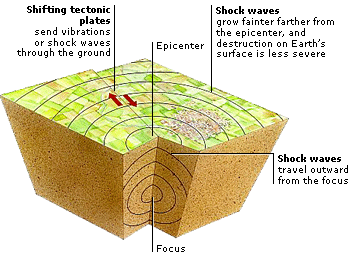DK Earth: Earthquakes
Earthquakes are vibrations triggered by sudden rock movements deep underground, which cause Earth’s surface to shake. Major earthquakes can shatter whole cities, killing people and bringing buildings and bridges crashing down.
Earthquakes are caused by the movements of the huge tectonic plates that make up Earth’s outer crust. Driven by currents in the semi-molten layer below the crust, the plates slowly drift over Earth’s surface and collide, grind together, or pull apart. Most earthquakes occur on fault lines—cracks in Earth’s crust where two plates meet and grind together.
As tectonic plates grind together at a fault line, the rocks on either side stretch to absorb a certain amount of pressure. If the pressure becomes too great, the rocks shatter, releasing shock waves that shake the surface. Buildings then sway and topple, and fires may start as gas and electricity lines are ripped apart.
Most earthquakes, and also volcanic eruptions, occur on or near the edges of Earth’s tectonic plates. They are most common in the “Ring of Fire,” the name given to the edge of the vast Pacific Plate that lies beneath the Pacific Ocean. Japan, the Philippines, New Zealand, and the western coastline of North and South America all lie in this major fault zone.
The study of earthquakes is called seismology. Scientists measure and record earthquakes using devices called seismometers. The size of an earthquake is measured according to its magnitude (the size of the shock waves and the energy produced) or its effects.

